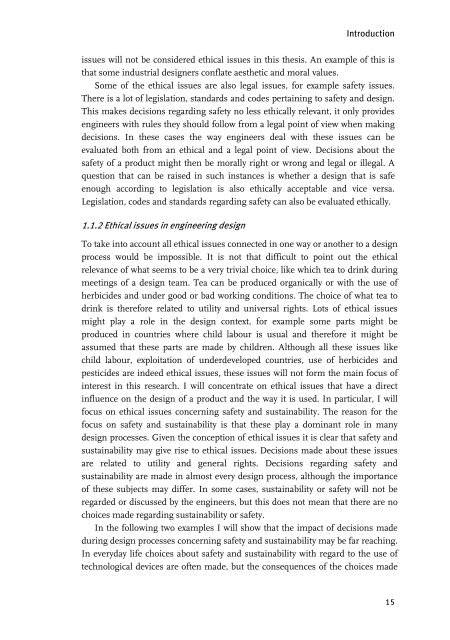Ethical issues in engineering design - 3TU.Centre for Ethics and ...
Ethical issues in engineering design - 3TU.Centre for Ethics and ...
Ethical issues in engineering design - 3TU.Centre for Ethics and ...
Create successful ePaper yourself
Turn your PDF publications into a flip-book with our unique Google optimized e-Paper software.
Introduction<br />
<strong>issues</strong> will not be considered ethical <strong>issues</strong> <strong>in</strong> this thesis. An example of this is<br />
that some <strong>in</strong>dustrial <strong>design</strong>ers conflate aesthetic <strong>and</strong> moral values.<br />
Some of the ethical <strong>issues</strong> are also legal <strong>issues</strong>, <strong>for</strong> example safety <strong>issues</strong>.<br />
There is a lot of legislation, st<strong>and</strong>ards <strong>and</strong> codes perta<strong>in</strong><strong>in</strong>g to safety <strong>and</strong> <strong>design</strong>.<br />
This makes decisions regard<strong>in</strong>g safety no less ethically relevant, it only provides<br />
eng<strong>in</strong>eers with rules they should follow from a legal po<strong>in</strong>t of view when mak<strong>in</strong>g<br />
decisions. In these cases the way eng<strong>in</strong>eers deal with these <strong>issues</strong> can be<br />
evaluated both from an ethical <strong>and</strong> a legal po<strong>in</strong>t of view. Decisions about the<br />
safety of a product might then be morally right or wrong <strong>and</strong> legal or illegal. A<br />
question that can be raised <strong>in</strong> such <strong>in</strong>stances is whether a <strong>design</strong> that is safe<br />
enough accord<strong>in</strong>g to legislation is also ethically acceptable <strong>and</strong> vice versa.<br />
Legislation, codes <strong>and</strong> st<strong>and</strong>ards regard<strong>in</strong>g safety can also be evaluated ethically.<br />
1.1.2 <strong>Ethical</strong> <strong>issues</strong> <strong>in</strong> eng<strong>in</strong>eer<strong>in</strong>g <strong>design</strong><br />
To take <strong>in</strong>to account all ethical <strong>issues</strong> connected <strong>in</strong> one way or another to a <strong>design</strong><br />
process would be impossible. It is not that difficult to po<strong>in</strong>t out the ethical<br />
relevance of what seems to be a very trivial choice, like which tea to dr<strong>in</strong>k dur<strong>in</strong>g<br />
meet<strong>in</strong>gs of a <strong>design</strong> team. Tea can be produced organically or with the use of<br />
herbicides <strong>and</strong> under good or bad work<strong>in</strong>g conditions. The choice of what tea to<br />
dr<strong>in</strong>k is there<strong>for</strong>e related to utility <strong>and</strong> universal rights. Lots of ethical <strong>issues</strong><br />
might play a role <strong>in</strong> the <strong>design</strong> context, <strong>for</strong> example some parts might be<br />
produced <strong>in</strong> countries where child labour is usual <strong>and</strong> there<strong>for</strong>e it might be<br />
assumed that these parts are made by children. Although all these <strong>issues</strong> like<br />
child labour, exploitation of underdeveloped countries, use of herbicides <strong>and</strong><br />
pesticides are <strong>in</strong>deed ethical <strong>issues</strong>, these <strong>issues</strong> will not <strong>for</strong>m the ma<strong>in</strong> focus of<br />
<strong>in</strong>terest <strong>in</strong> this research. I will concentrate on ethical <strong>issues</strong> that have a direct<br />
<strong>in</strong>fluence on the <strong>design</strong> of a product <strong>and</strong> the way it is used. In particular, I will<br />
focus on ethical <strong>issues</strong> concern<strong>in</strong>g safety <strong>and</strong> susta<strong>in</strong>ability. The reason <strong>for</strong> the<br />
focus on safety <strong>and</strong> susta<strong>in</strong>ability is that these play a dom<strong>in</strong>ant role <strong>in</strong> many<br />
<strong>design</strong> processes. Given the conception of ethical <strong>issues</strong> it is clear that safety <strong>and</strong><br />
susta<strong>in</strong>ability may give rise to ethical <strong>issues</strong>. Decisions made about these <strong>issues</strong><br />
are related to utility <strong>and</strong> general rights. Decisions regard<strong>in</strong>g safety <strong>and</strong><br />
susta<strong>in</strong>ability are made <strong>in</strong> almost every <strong>design</strong> process, although the importance<br />
of these subjects may differ. In some cases, susta<strong>in</strong>ability or safety will not be<br />
regarded or discussed by the eng<strong>in</strong>eers, but this does not mean that there are no<br />
choices made regard<strong>in</strong>g susta<strong>in</strong>ability or safety.<br />
In the follow<strong>in</strong>g two examples I will show that the impact of decisions made<br />
dur<strong>in</strong>g <strong>design</strong> processes concern<strong>in</strong>g safety <strong>and</strong> susta<strong>in</strong>ability may be far reach<strong>in</strong>g.<br />
In everyday life choices about safety <strong>and</strong> susta<strong>in</strong>ability with regard to the use of<br />
technological devices are often made, but the consequences of the choices made<br />
15



